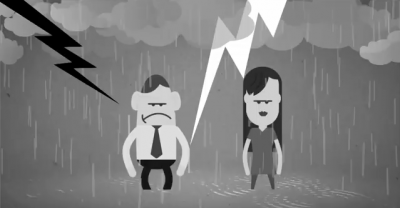“Good business for everybody” is the message of a twee animated cartoon promoting the EU’s 2030 goals for climate and energy. European politicians try to sell their ambitious climate goals and the proposed regulations to their citizens as a nice fairy tale: Policy driven investments in green technologies that cut emissions will not only save the world but also boost the economy, create jobs and strengthen Europe’s competitiveness.
Subscribing the questionable statement that global warming should be kept below two degree Celsius to preventing the most severe impacts of climate change, EU leaders have committed to transform Europe into a highly energy-efficient, low carbon economy. By 2030 greenhouse gas (GHG) emissions are targeted to a 40 percent reduction and to 80 percent by 2050. To get this done the EU will implement dozens of new policies and measures, reform the EU Emissions Trading System, adopt legislation to raise the share of energy consumption from renewable energy source to 27 percent by 2030 and increase energy efficiency by at least 27 percent.
While boasting that the EU already reduced GHG emissions by 18 percent since 1990 while EU’s GDP has grown by 45 percent, politicians hide the fact that most of the reduction was achieved by the late nineteens when most of the industrial heritage of former communist countries was deconstructed. Then the GHG emissions more or less remained at the same level until the beginning of the world economic crisis in 2008. The following drop of GHG emissions signified rather the beginning of an industrial exodus from Europe than a triumph of climate policy. Therefore the cheap fruits of emission reductions are already reaped; further steps to reduce emissions while keeping the economy flourishing will be very expensive. Not only Germany’s energy intensive industry complains about rising energy prices which lead to a decrease of its world market competitiveness. Poland’s government already stepped on the breaks during the negotiations of the EU goals fearing substantial costs of more ambitious emission reductions. Europe’s THG emission goals will have a high price tag. Meanwhile non-EU-Countries increase their emissions by taking over energy intensive industries. Therefore the influence of Europe’s climate policy leadership on the effectiveness of global climate mitigation will stay negligible.
This cost dilemma also applies to Europe’s energy efficiency goals. Energy efficiency is not to be confused with economic efficiency necessary to boost the economy and make everybody happy with climate policy. Energy efficiency is expensive especially in times of decreasing energy prices. If business has to spend more money on energy saving technologies or loses more revenue by a decline in production than it gets back from reduced energy expenses energy efficiency is clearly a loss, not only for the affected enterprise but for the economy as a whole. Efficiency standards or subsidies don’t differentiate between profitability and loss. There is no way to find out whether certain measures are cost effective if the government conceals the market price signal. Therefore a 27 percent efficiency goal is bound to stifle the European economy. Moreover, in industries subject to the European emissions trading regime energy efficiency is rather useless regarding the reduction of GHG emissions. Emission reductions here will be compensated by additional emissions there.
The provision of a reform and strengthening of the EU emissions trading system is questionable at best. Since its implementation it is criticized by economists for its sectorial approach instead of covering at least all economy wide carbon emissions in the EU. A comprehensive system would level out the marginal cost of emissions reductions over the whole economy and guarantee the minimization of mitigation costs of Europe’s emission goals. Instead the European Commission implements a rather arbitrary 43 percent greenhouse gas reduction target for the affected sectors, implying a steeper emissions cap declining as provided before. In addition, the Commission proposed to establish a market stability reserve from 2021 onwards to address the alleged surplus of emission allowances in The EU Emissions Trading System (EU ETS) that has built up in recent years and to induce more low-carbon investment. But to manipulate the EU ETS cap to receive higher allowance prices for more investment incentives gets the idea of emissions trading completely backwards. Either politicians set sensible emission goals and allow the allowance prices to float free or they set a price tag for carbon and the economy is free to reduce its emissions accordingly. Mixing up emissions trading and carbon taxes to target low carbon investments will never lead to efficiency.
Clearly it is wishful thinking to believe that this EU climate action plan is good business for everybody. Outside Europe no country buys into the idea that it is worthwhile to follow the European Union self-proclaimed leadership. Nobody else seems to be suicidal enough to dispatch their economy by joining Europe’s ambitious climate policy goals. For instance China is building coal gasification plants at rapid speed in order to contain its smog problem and to supply its population with needed power, despite the fact that carbon dioxide emissions will be even greater than if it built coal-fired plants directly. This suggests that the proposed knock-on effect of the EU’s climate goals for the rest of the world is merely a pipe dream. Therefore the EU climate policy will result in bad business for everybody except for the army of profiteers from impediments to competition and subsidies lobbying for more and more climate policy regulation in Brussels.



















1 Comment
Steffen Hentrich über das Luftschloss der EU-Klimapolitik